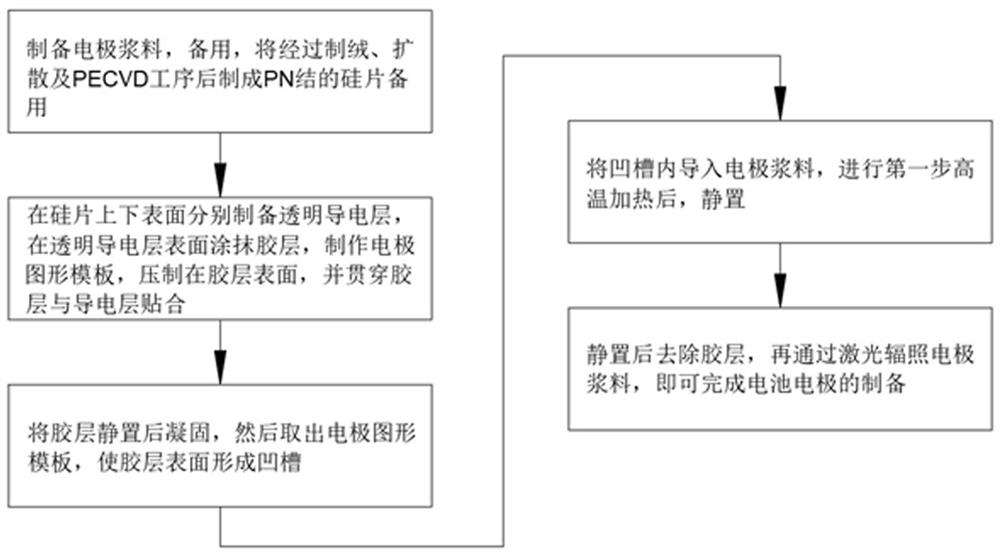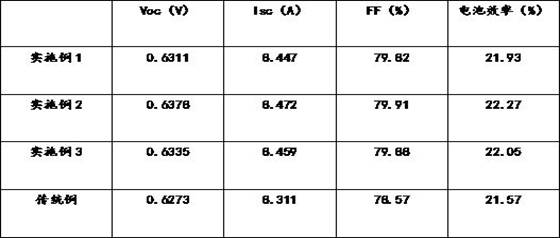Method for preparing crystalline silicon solar cell electrode through laser melting
A technology of solar cells and laser melting, applied in photovoltaic power generation, conductive materials dispersed in non-conductive inorganic materials, circuits, etc. To achieve the effect of maintaining the flow viscosity, lowering the adhesive strength, and increasing the peelability
- Summary
- Abstract
- Description
- Claims
- Application Information
AI Technical Summary
Problems solved by technology
Method used
Image
Examples
Embodiment 1
[0026] Embodiment 1 A method for preparing a crystalline silicon solar cell electrode by laser melting, including:
[0027] 1. Preparation of electrode paste
[0028] 1. Heat and melt 1 part of acrylic resin, add 3 parts of ethyl cellulose, stir and mix, then add the mixture to terpineol and butyl carbitol acetate solution and blend to obtain an organic carrier;
[0029] 2. Add 1 part of lead-free low-melting glass powder and 30 parts of nano-silver powder into 15 parts of organic carrier, disperse and stir, and grind to a small particle size by a grinder after drying to prepare electrode slurry, and its particle size is 10 -12um, providing powder with smaller particle size, which can optimize the conductivity of the electrode;
[0030] 2. Preparation of solar cell electrodes
[0031] 1. Prepare electrode slurry for standby, and prepare silicon wafers with PN junction after texturing, diffusion and PECVD processes for standby;
[0032] 2. Prepare a transparent conductive la...
Embodiment 2
[0037] Embodiment 2 A method for preparing a crystalline silicon solar cell electrode by laser melting, comprising:
[0038] 1. Preparation of electrode paste
[0039] 1. Heat and melt 2 parts of acrylic resin, add 5 parts of ethyl cellulose, stir and mix, then add the mixture to terpineol and butyl carbitol acetate solution and blend to obtain an organic carrier;
[0040] 2. Add 3 parts of lead-free low-melting glass powder and 35 parts of nano-silver powder into 17 parts of organic carrier, disperse and stir, and grind it to a small particle size by a grinder after drying, and then the electrode slurry can be prepared, and its particle size is 10 -12um, providing powder with smaller particle size, which can optimize the conductivity of the electrode;
[0041] 2. Preparation of solar cell electrodes
[0042] 1. Prepare electrode slurry for standby, and prepare silicon wafers with PN junction after texturing, diffusion and PECVD processes for standby;
[0043] 2. Prepare a ...
Embodiment 3
[0047] Embodiment 3 A method for preparing a crystalline silicon solar cell electrode by laser melting, comprising:
[0048] 1. Preparation of electrode paste
[0049] 1. Heat and melt 3 parts of acrylic resin, add 7 parts of ethyl cellulose, stir and mix, then add the mixture to terpineol and butyl carbitol acetate solution and blend to obtain an organic carrier;
[0050] 2. Add 5 parts of lead-free low-melting glass powder and 40 parts of nano-silver powder into 20 parts of organic carrier, disperse and stir, and grind to a small particle size by a grinder after drying to prepare electrode slurry, and its particle size is 10 -12um, providing powder with smaller particle size, which can optimize the conductivity of the electrode;
[0051] 2. Preparation of solar cell electrodes
[0052] 1. Prepare electrode slurry for standby, and prepare silicon wafers with PN junction after texturing, diffusion and PECVD processes for standby;
[0053] 2. Prepare a transparent conductive l...
PUM
 Login to View More
Login to View More Abstract
Description
Claims
Application Information
 Login to View More
Login to View More - R&D
- Intellectual Property
- Life Sciences
- Materials
- Tech Scout
- Unparalleled Data Quality
- Higher Quality Content
- 60% Fewer Hallucinations
Browse by: Latest US Patents, China's latest patents, Technical Efficacy Thesaurus, Application Domain, Technology Topic, Popular Technical Reports.
© 2025 PatSnap. All rights reserved.Legal|Privacy policy|Modern Slavery Act Transparency Statement|Sitemap|About US| Contact US: help@patsnap.com


